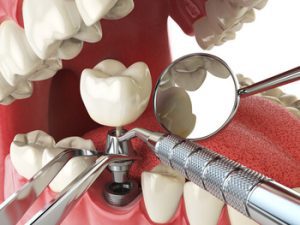With the evolution of dental treatment, dental implants have surged in popularity. They’re the new buzzword in the dental community, and for good reason. But one nagging question remains ever-present for Australians considering the procedure: How much does the cost of dental implants in Australia amount to? Let’s delve in.
What is a Dental Implant?
Dental implants stand tall as a testament to the revolutionary strides made in dental science. Unlike conventional methods that merely address the superficial appearance of missing teeth, dental implants delve deeper—quite literally—serving not just as a cosmetic solution but as a functional one. Predominantly in Australia, as the awareness about oral health amplifies, the allure of dental implants as a comprehensive solution to missing teeth is undeniable.
The Essence of an Implant
In layman’s terms, a dental implant is a synthetic counterpart to the root of a natural tooth. Crafted from biocompatible materials, primarily titanium, it’s strategically designed to integrate seamlessly with the jaw bone.
This osseointegration ensures that the implant is securely anchored, paving the way for the subsequent dental prosthesis—a crown, bridge, or even a denture—to be attached confidently.
A Deeper Dive: The Anatomy of a Dental Implant
The Abutment: Acting as a liaison between the implant root and the visible prosthetic tooth, the abutment is an essential intermediary. Protruding just above the gum line, it’s engineered to support the final dental piece, ensuring a snug and natural fit.
The Prosthetic Crown: The piece de resistance of the entire dental implant procedure, the part that bestows that natural, radiant smile. Crafted typically from ceramic or porcelain, it’s designed to mimic the appearance and function of natural teeth, blending seamlessly with its neighbours.
A Solution for Today and Tomorrow
One of the most compelling aspects of dental implants is their longevity. Unlike other tooth replacement options, which might require periodic adjustments or replacements, a well-placed and maintained dental implant can last a lifetime.
This durability and aesthetic and functional benefits solidify its position as a frontrunner in tooth replacement options.
Dental implants are more than just a dental procedure; they represent a harmonious blend of science, art, and technology, promising a restored smile and a restoration of confidence and quality of life.
Factors Affecting the Cost
Navigating the intricacies of dental implant costs can be challenging. Still, with a keen understanding of these driving factors, prospective patients can make informed decisions that align with their oral health needs and financial considerations.
Nature and Scope of the Procedure
At the heart of the dental implants cost is the implant procedure one requires. Whether you’re considering replacing a single tooth or contemplating full mouth dental implants, the scope significantly influences the overall expenses. Simple logic dictates the more implants you need, the higher the cost, but this is often offset by the bulk nature of the work.
Material Matters: Titanium vs. Zirconia
Predominantly, dental implants are crafted from either titanium or zirconia. Both materials have their merits. Titanium, known for its impressive strength and biocompatibility, has been the material of choice for years. Zirconia, on the other hand, is often preferred for its tooth-like colour and hypoallergenic properties. The choice of material can influence dental implant costs, with zirconia typically commanding a higher price due to its aesthetic advantages.
Expertise and Experience of the Dentist
Quality dental implant treatment is as much an art as a science. The hands that craft and place your implant matter. A seasoned dentist with extensive experience in dental implant procedures might charge more than a novice. However, their vast experience often translates to higher success rates, reduced risk of complications, and an overall smoother procedure, making the additional expense worthwhile.
Geographical Location and Clinic Overheads
With their high operational costs, metropolitan hubs like Sydney, Melbourne, or Brisbane might have a steeper dental implant price tag than more regional or suburban areas. Clinic overheads, rent, staff salaries, and the local competitive landscape play a role. It’s worth noting, however, that clinics in urban centres might have access to more advanced technologies or procedures.
Associated Procedures: Beyond the Basic Implant
Sometimes, the journey to a dental implant surgery involves more than just placing the tooth implant. Supplementary procedures can often factor into the overall cost:
- Bone Grafting: A bone graft might be essential for patients with insufficient jaw bone density to create a solid foundation for the implant. This procedure adds to the cost, whether sourced from another part of the patient’s body or a synthetic material.
- Sinus Lift: Especially relevant for implants in the upper jaw, a sinus lift or augmentation adjusts the sinus position to make room for the implant.
- Tooth Extractions: If the patient has damaged or decayed teeth that need removal before the dental implant procedure, this will add to the overall dental treatment cost.
Bringing it All Together: The Comprehensive Costing
Taking a step back and viewing the cost of dental implants holistically, it’s evident that the pricing isn’t arbitrary. It culminates various factors—from material choice to geographical nuances, from the dentist’s experience to potential adjunct procedures.
The Price Range
Dental implants, often touted as the premier solution for missing teeth, come with various price tags. Much like shopping for a car or a piece of real estate, the price range can be vast. It’s shaped by many factors, as previously discussed, from the type of material used to the dentist’s expertise. But what can someone in Australia realistically expect to pay?
Single Dental Implant: Starting Simple
A single dental implant, often the go-to for an individual missing tooth, is generally the least costly option in dental implants. Based on data from the National Dental Fee Survey and various dental insurance providers, the cost for a single dental implant in Australia can range anywhere from $3,000. The variance is influenced by location, dentist expertise, and material choice.
Multiple Implants: Scaling Up
As one might intuitively surmise when the number of missing teeth grows, so does the price. Multiple implants can range from $6,000. This wide range speaks to the possible scenarios: replacing two teeth vastly differs from replacing an entire jaw’s worth. Some clinics may offer a ‘bulk’ discount when many implants are required, reducing the per-implant cost.
Full Mouth Dental Implants: The All-Inclusive Approach
Full mouth dental implants are the ultimate solution for those looking at a complete overhaul. Given the comprehensive nature of this procedure, costs can range from $20,000. While the initial sticker shock might be palpable, it’s essential to understand this includes both upper and lower jaws, potentially involving bone grafts, sinus lifts, and other adjunct procedures that drive up the price.
Hidden and Ancillary Costs: Things to Watch For
While the figures mentioned provide a ballpark, there are often additional costs that can spring up, much like hidden fees in other sectors:
- Consultation Fees: While some clinics might roll this into the overall dental implant cost, others charge separately for the initial consult.
- Post-Procedure Care: From follow-up visits to specific oral care products, these can add to the bill.
- Dental Insurance Considerations: While dental insurance might cover a portion of the cost, it’s rare for policies to cover all dental implant procedures. It’s crucial to factor in out-of-pocket expenses even with insurance in play.
Weighing Value Against Cost
While the price range for dental implants in Australia is undoubtedly expansive, viewing this as an investment is crucial. Dental implants offer unparalleled longevity, functionality, and aesthetic appeal compared to other tooth replacement methods. When weighing the cost, it’s not just about the immediate expense but the long-term value and improved quality of life.
In conclusion, the landscape of dental implant costs in Australia is as diverse as the nation itself. By understanding the various factors and seeking out transparent clinics that provide clear cost breakdowns, individuals can embark on their dental implant journey with clarity and confidence.
Ways to Save Money (Without Compromising Quality)
Knowledge is Power: Research and Compare
As with any significant investment, it pays to do your homework. You can gain a comprehensive view of the pricing landscape by researching various clinics and practitioners. Some clinics offer promotional packages or discounts on certain dental treatments. Moreover, reading reviews and testimonials can give you an idea of where the best value for money lies.
Opt for Payment Plans
Many clinics understand the financial implications of dental implant procedures and, to make them more accessible, offer flexible payment plans. This way, rather than shouldering the entire cost upfront, you can spread the expense over several months or even years. While you might pay more in the long run due to interest, the monthly outgoings are more manageable.
Comprehensive Dental Plans
Spending more money to save money might sound counterintuitive, but sometimes, investing in a comprehensive dental insurance plan can yield long-term savings. While most dental insurance plans won’t cover the full cost of dental implants, they may cover a percentage of associated procedures like extractions, reducing the overall expense. Always read the fine print and understand the claim process.
Leverage Seasonal Offers
Some dental clinics run seasonal promotions or discounts during specific times of the year. By timing your procedure right, you could avail of these discounts. It’s common for clinics to offer specials during new financial years or even holiday seasons.
Quality Over Quantity: Prioritise Necessary Procedures
While opting for a full overhaul is tempting, sometimes focusing on the most necessary implants first can spread out the financial burden. Consult with your dentist on the most urgent implants, and consider spacing out procedures to manage costs better.
Consider Package Deals
In scenarios where multiple procedures or implants are required, some clinics might offer package deals or bundled offers. For instance, if bone grafting and a dental implant procedure are needed, a combined package might be available at a reduced rate.
Seek Referrals and Loyalty Programs
Word-of-mouth is still a powerful tool. Some clinics offer discounts or perks for referred patients. If a friend or family member has had a positive experience somewhere, there might be a financial benefit in following their lead. Also, loyalty programs or repeat customer discounts might be available for those who’ve been with a particular clinic for a while.
Invest in Preventative Care
Although this isn’t a direct saving on the dental implant cost, maintaining good oral hygiene and regularly visiting the dentist for check-ups can prevent further issues that necessitate more implants. Prevention, as they say, is often cheaper than the cure.
Risks of Opting for Cheaper Alternatives
The age-old adage often holds in dental care, especially with procedures as significant as dental implants: “You get what you pay for.” It’s essential to weigh the potential long-term risks and costs against the initial savings. Prioritising health and quality can save money and prevent unnecessary pain and complications.
Compromised Material Quality
When the cost is the primary driver behind the choice of dental implants, there’s a risk of ending up with implants made of inferior materials. High-quality dental implants are typically made from medical-grade titanium or zirconia, renowned for their strength and biocompatibility. Cheaper alternatives might not meet these standards, leading to:
Corrosion or Wear: Inferior metals can corrode or wear down over time, leading to implant failure or releasing harmful substances.
Reduced Biocompatibility: This can result in the body rejecting the implant, causing inflammation, pain, and potential failure of the dental implant to integrate with the jaw bone.
Less Experienced Dental Practitioners
You often get what you pay for, which is especially true in dental care. Reduced costs might mean the procedure is performed by a less experienced dentist in dental implant procedures. This can lead to:
Incorrect Placement: Improperly placed dental implants can lead to chronic pain, misalignment, and bite and jaw function complications.
Higher Failure Rates: Inexpertly placed implants may not fuse properly with the jaw bone, leading to a higher likelihood of failure.
Inadequate Pre- and Post-Procedure Care
Poor Treatment Planning: Inadequate diagnostic tools or rushed consultations can result in unforeseen complications during the dental implant procedure.
Lack of Follow-Up: Proper post-operative care is crucial for the success of dental implants. With regular follow-ups, complications may be noticed once they become major issues.
Hidden Costs and Fees
Some clinics may offer low initial costs but make up for these with hidden fees, making the procedure ultimately more expensive. For instance, they might charge separately for essential elements of the procedure, like X-rays or anaesthesia, which can catch patients off-guard.
Lower Longevity of Implants
Cheaper dental implants might last less time than their high-quality counterparts. This means that while you save money initially, you could pay more for replacements or repairs in the long run.
Increased Risk of Infections
Cutting costs might mean compromising on sterilisation or cleanliness standards. This can significantly increase the risk of post-operative infections, which can be painful, endanger the success of the implant, and, in extreme cases, become life-threatening.
Compromised Aesthetic Results
Opting for cheaper alternatives could also affect the final look of the dental implant. The implant might not match the natural teeth in colour, size, or shape, leading to a less-than-ideal aesthetic outcome.
Conclusion
Navigating the cost of dental implants in Australia can feel like tiptoeing through a minefield. But with informed decisions, you can restore your missing teeth without undue strain on your wallet. Dental implants offer a lasting solution, blending seamlessly with natural teeth and ensuring you can bite, chew, and smile with renewed confidence. When weighing the cost of dental implants, it’s worth pondering the life-enhancing benefits they bring to the table.
If you’re considering dental implants or have more questions about the process, keep your expertise and quality high. Contact the dedicated and experienced team at Casey Dentists. With a reputation for excellence and a patient-first approach, you’ll be in skilled hands. Make an informed decision for your oral health today.
Reach out to Casey Dentists at (07) 4801 7035 to schedule a consultation or to get answers to any queries you might have. Your journey to a confident and healthy smile starts with a simple call.
References:
https://my.clevelandclinic.org/health/treatments/10903-dental-implants
https://www.dentalhealth.org/dental-implants



